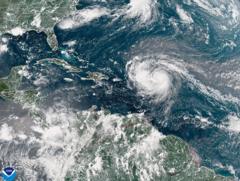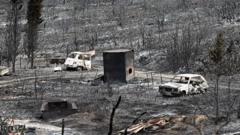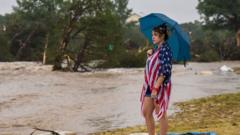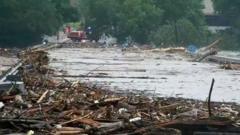Hurricane Erin rapidly intensified into a category five storm with destructive winds, prompting warnings for heavy rainfall, dangerous surf conditions, and potential flooding in its path through the Caribbean and along the US East Coast.
Hurricane Erin Dangers Loom as Category Five Storm Develops
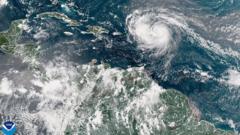
Hurricane Erin Dangers Loom as Category Five Storm Develops
Category five Hurricane Erin exhibits maximum winds of 160 mph, posing severe risks to the surrounding regions.
Hurricane Erin has significantly intensified to a category five storm, boasting maximum sustained winds of 160 mph (260 km/h). According to Mike Brennan, Director of the National Hurricane Center, the storm experienced an "explosive" strengthening phase overnight after evolving from a tropical storm on Friday. Set to pass north of the Leeward Islands, the Virgin Islands, and Puerto Rico this weekend, Erin could deliver up to 6 inches (15 cm) of rain, raising concerns over flash flooding and mudslides in affected areas. Being the first hurricane of the 2025 Atlantic season, Erin is not forecast to directly strike the mainland US.
The rapid intensification process of Erin involved a wind speed increase of at least 34 mph within a mere 24-hour timeframe. Mr. Brennan noted that winds surged from 100 mph early Saturday morning to their current fearsome level of 160 mph. Projections indicate that next week, Hurricane Erin will gradually shift northward, moving past the eastern Bahamas and towards North Carolina's Outer Banks.
While monitoring its path, Mr. Brennan cautioned that Erin's presence would generate life-threatening surf and rip currents along nearly the entire East Coast of the United States next week. The most hazardous surf conditions are expected for Florida and the mid-Atlantic states. Regions like Bermuda should also prepare for potential torrential rain and dangerous surf conditions.
Given the gale-force winds, the US Coast Guard has established restrictions for vessels at ports in St. Thomas and St. John in the US Virgin Islands, as well as in six municipalities across Puerto Rico, including its capital, San Juan. The National Oceanic and Atmospheric Administration (NOAA) forecasts an "above normal" hurricane season in the Atlantic, attributing the rise in powerful storms, particularly category four and five hurricanes, to the impacts of global warming.

